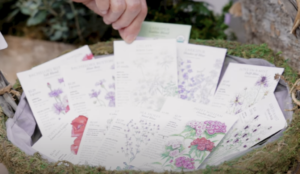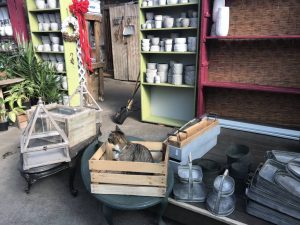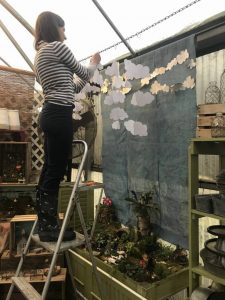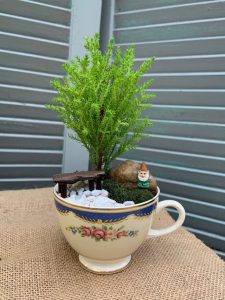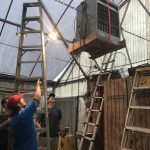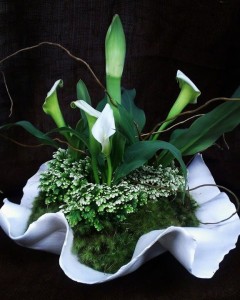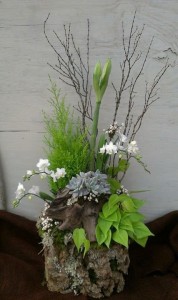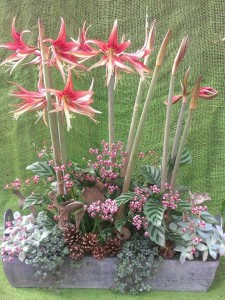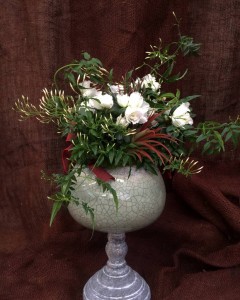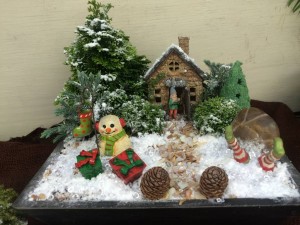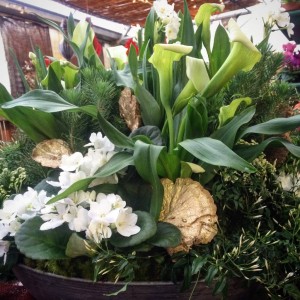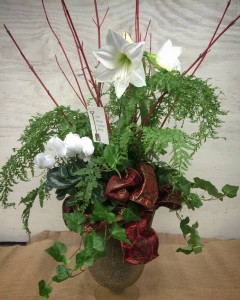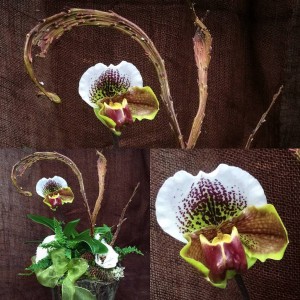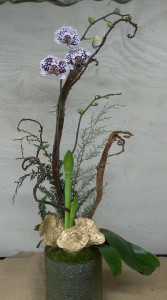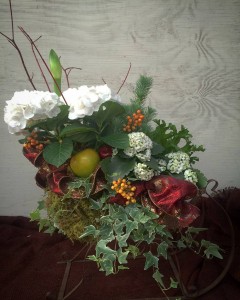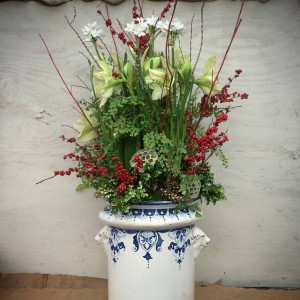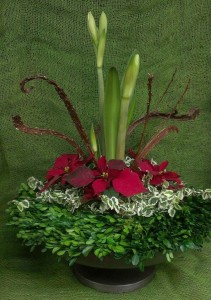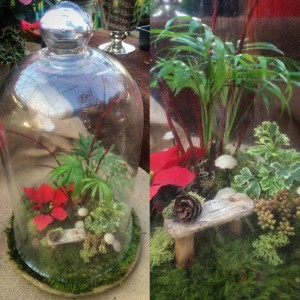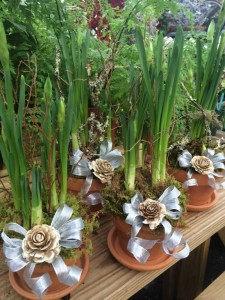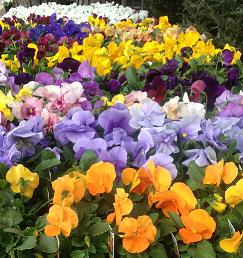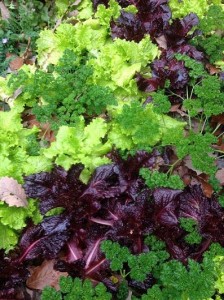Category Archives: Winter
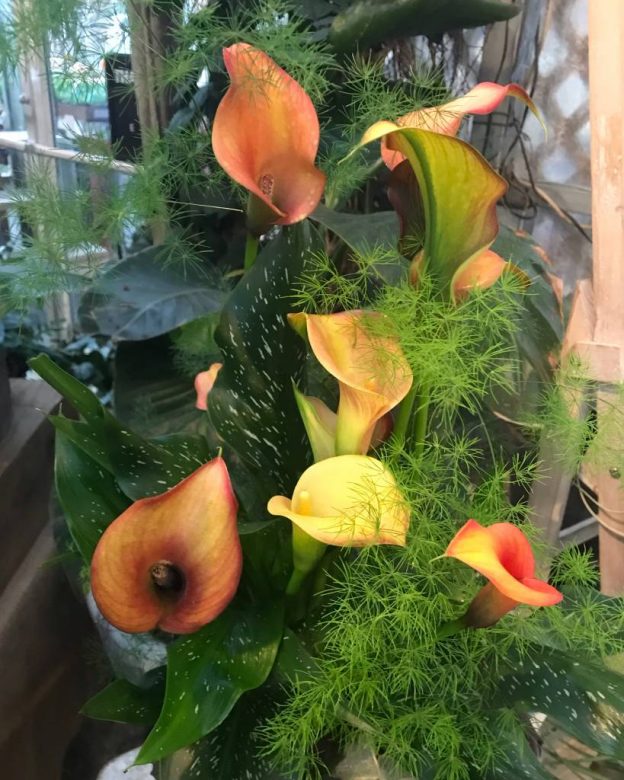
The Winter Greenhouse Is Lush With Houseplants and Flowers
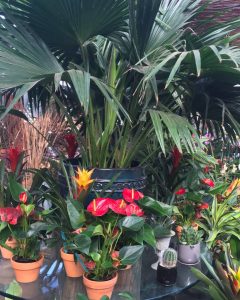 If you’ve never stepped into a lush greenhouse in the middle of winter on a rainy, cold day (or any day for that matter), you’re in for a real treat.
If you’ve never stepped into a lush greenhouse in the middle of winter on a rainy, cold day (or any day for that matter), you’re in for a real treat.
January was a turn the greenhouse upside down month, as pretty much every last thing was moved and rearranged, including one entire area that held an abundance of pots.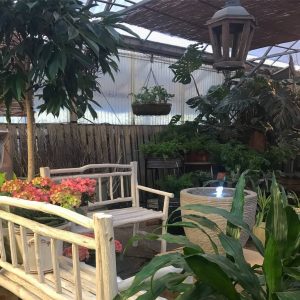
Anyone who ever said working in a greenhouse was a walk in the park never worked with us! Hard work aside, we’re pleased with the changes and hope you like it as well.
The cats took part too, though Tacca was more than happy to settle into a box and watch the goings on, and they all found new spots to take naps!
Liam, true to his personality, likes to be center stage, right at the front door where everyone who sees him gives him a pet, and sometimes Tacca joins him there.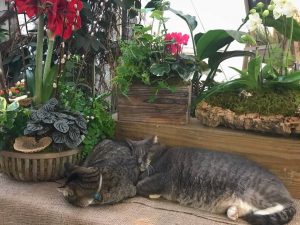
Of course there are beautiful houseplants of all sizes in the greenhouse, and we pay attention to them so they’re at their best when you take them home. We’re all plant junkies too and are always on the lookout for new and different offerings (One for you, one for me…).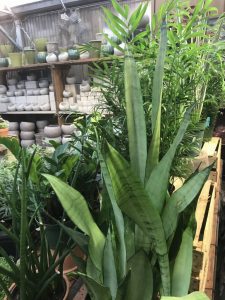
For everyone who loves tiny, miniature garden magic, Haley has taken over the display, transforming a corner of the greenhouse.
Our fairyland table now has a new backdrop and floating clouds above it. It’s a special spot for the young and the young at heart.
Margaret was inspired to make her own little garden in a teacup. She had a little gnome; now he lives under a “tree” with a bench nearby if he wants to sit a spell. It is so cute!
Perhaps you have an interesting container you’d like to work a little miniature magic on. They’re so much fun, and we have everything you need to make it happen.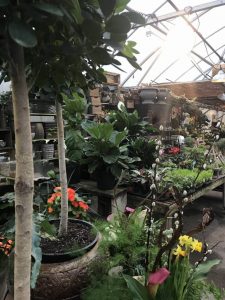
If you’re on social media, we are too! We were discussing the other day that the shop is the perfect spot to take social media pictures, so look for us on FaceBook – Oak Street Garden Shop and Local Market, Pinterest, and Instagram too.
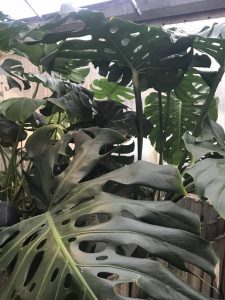 Then, while you’re visiting the shop, take a selfie and tag us (We have the perfect monstera for #monsteramonday !). The enormous pot ours is planted in was rotated, the huge leaves cleaned, and lots of pictures were taken of it. It has been our shop mascot for many years now, and we think it’s worthy of Instagram fame!
Then, while you’re visiting the shop, take a selfie and tag us (We have the perfect monstera for #monsteramonday !). The enormous pot ours is planted in was rotated, the huge leaves cleaned, and lots of pictures were taken of it. It has been our shop mascot for many years now, and we think it’s worthy of Instagram fame!
We all appreciate being warm, and well maintained and reliable heaters are the backbone of any greenhouse. One of ours finally wore out after almost 30 years of use, and while replacing it took the better part of a rainy Saturday, we’re sure the plants (and us) will feel the difference.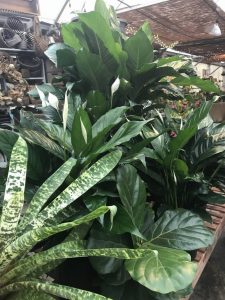
One thing is for sure, a lush greenhouse is the perfect place to be on any winter day – among houseplants and orchids, flowers, succulents, and blooming spring bulbs. Take a moment to walk through, you won’t be sorry!
By Kris Blevons

From Seed – The ‘Better Late Than Never’ Garden Puts On A Show!
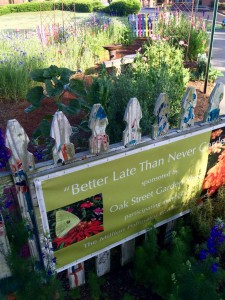 I’ll be honest, my hopes for a beautiful spring show in the ‘Better Late Than Never’ garden weren’t that great. Weather and time last fall seemed to conspire against me – no beautiful transplants of pansies, snapdragons, or foxgloves were put in the little plot across the street, even as everyone else was planning and planting their home gardens September through December. The summer garden went to seed and was finally pulled out with Ben’s help, in November.
I’ll be honest, my hopes for a beautiful spring show in the ‘Better Late Than Never’ garden weren’t that great. Weather and time last fall seemed to conspire against me – no beautiful transplants of pansies, snapdragons, or foxgloves were put in the little plot across the street, even as everyone else was planning and planting their home gardens September through December. The summer garden went to seed and was finally pulled out with Ben’s help, in November.
Sometimes, though, nature helps us along. Walking to my car at the end of early winter days I’d glance at the garden, its four beds seemingly lifeless plots of earth. If I had time I’d walk through, looking to see if any seedlings were emerging. There were, zinnias and sunflowers mostly, seeds dropped from fading blooms, germinating in the still warm soil. But I knew these were destined to freeze in the upcoming winter chill. Oh well, I thought, maybe I can get something in after the holidays.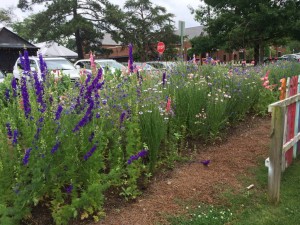
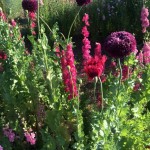 The weeks of late summer through fall had passed quickly. We held Molly’s wedding at the shop, and autumn plants and loads of pumpkins arrived and went. The days flew by during the frenetic holiday season that ended as suddenly as it started. January, and a new year, had arrived.
The weeks of late summer through fall had passed quickly. We held Molly’s wedding at the shop, and autumn plants and loads of pumpkins arrived and went. The days flew by during the frenetic holiday season that ended as suddenly as it started. January, and a new year, had arrived.
I finally had more time to concentrate on the little garden across the street with the apt name. I’d noticed, on the few December days I had a moment to look, that there were tiny bachelor button plants everywhere in 3 of the beds. I couldn’t do more than try to thin them out, though, with what little time I had.
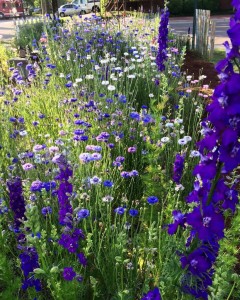 They’d bloomed in the garden the spring prior and had most definitely reseeded, but with barely any thinning were carpeting 3 of the beds quite thickly. I watched them fill in with some alarm. Would they smother themselves out because they were too close together? I decided to let well enough be and see what would happen.
They’d bloomed in the garden the spring prior and had most definitely reseeded, but with barely any thinning were carpeting 3 of the beds quite thickly. I watched them fill in with some alarm. Would they smother themselves out because they were too close together? I decided to let well enough be and see what would happen.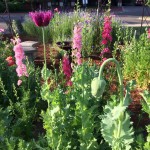
Spotting that bit of growth in the garden energized me. Even as the bachelor buttons were putting on their amazing growth spurt through January and February, I was tossing out seeds of larkspur in all shades.
I’d choose a few Botanical Interests seed packets off the rack, larkspur in shades of blue or mixes of blues, pinks, and whites. Eyeing the beds, I imagined perfect color combinations, letting the seed slip through my fingers onto the uneven soil.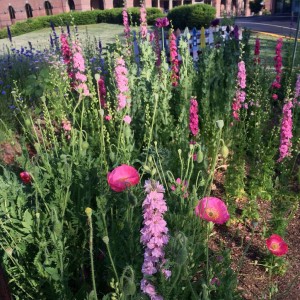
I scanned the garden each morning, hoping to see some spots of green. Impatient, I would scatter more seeds – packets of sweet alyssum, oriental poppies, mixed colors of larkspur – willing an abundance of flowers for spring.
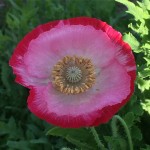 Finally I saw the ferny foliage of the larkspur here and there between the crowded bachelor buttons and the distinctive blue-green foliage of the oriental poppies appeared too.
Finally I saw the ferny foliage of the larkspur here and there between the crowded bachelor buttons and the distinctive blue-green foliage of the oriental poppies appeared too.
Each day as the plants grew, more and more people asked what was growing in the garden. I’d explain, smiling, about plants reseeding and seeds thrown onto the ground on cold winters days. Most people looked incredulous. From seed? Yes, I’d answer, seeds, and a prayer for spring.
By Kris Blevons
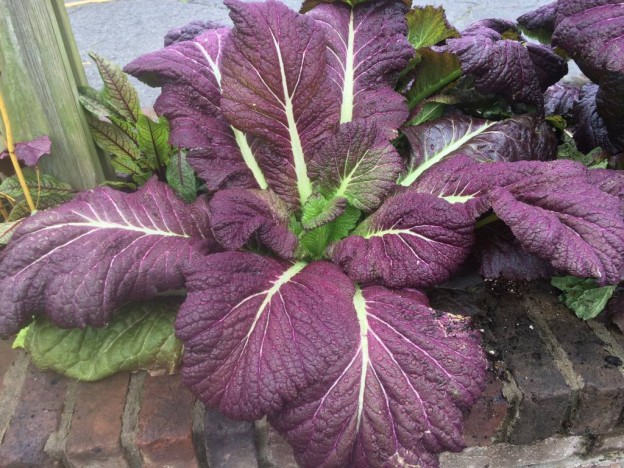
What Is That?!?? It’s ‘Red Giant’ Mustard!
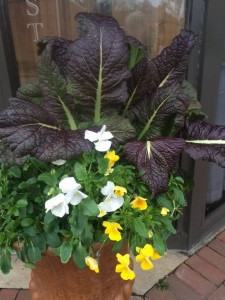 I’ve talked before of my love of foliage plants and how much I believe they add to planters and garden beds. Here is another that proves my point. I planted a few small pots of ‘Red Giant’ mustard in our sign planter out front, at the side of the shop in large troughs, and in urns at the front of the restaurant next door last November.
I’ve talked before of my love of foliage plants and how much I believe they add to planters and garden beds. Here is another that proves my point. I planted a few small pots of ‘Red Giant’ mustard in our sign planter out front, at the side of the shop in large troughs, and in urns at the front of the restaurant next door last November.
Now 4″ pots are not big at all, and the plants in them were quite small as well. But, if you know what that small plant will turn into, you can make some stunning combinations of your own. Just look at this!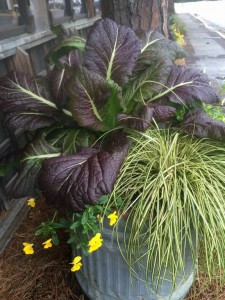
In fact, almost everyone who walks by any of these plantings asks what the big red leaves are and do we have any for sale?
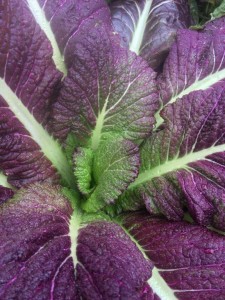 At its most impressive in the winter, that’s not always when it’s available. Though, if it is, you can be sure we’ll have it!
At its most impressive in the winter, that’s not always when it’s available. Though, if it is, you can be sure we’ll have it!
It will get knocked back by a freeze, but simply remove the most damaged leaves and usually it will grow back out from the center fairly quickly.
Make a note to ask about it in the fall when you’re planning your fall/spring garden plantings, because that’s when you’re likely to find this large and in charge plant. It’s truly stunning!
Some plants to combine with ‘Red Giant’ mustard in planters or garden beds:
Pansies, violas, herbs, including curly parsley, thyme (‘Archer’s Gold, variegated lemon); grassy foliage plants such as golden acorus or a variegated carex for contrast against the large mustard leaves; other greens such as ornamental kale (I’ve used lacinato to great affect.), spring blooming snapdragons to compliment the yellow blooms of the mustard as it bolts in the heat are a few suggestions.
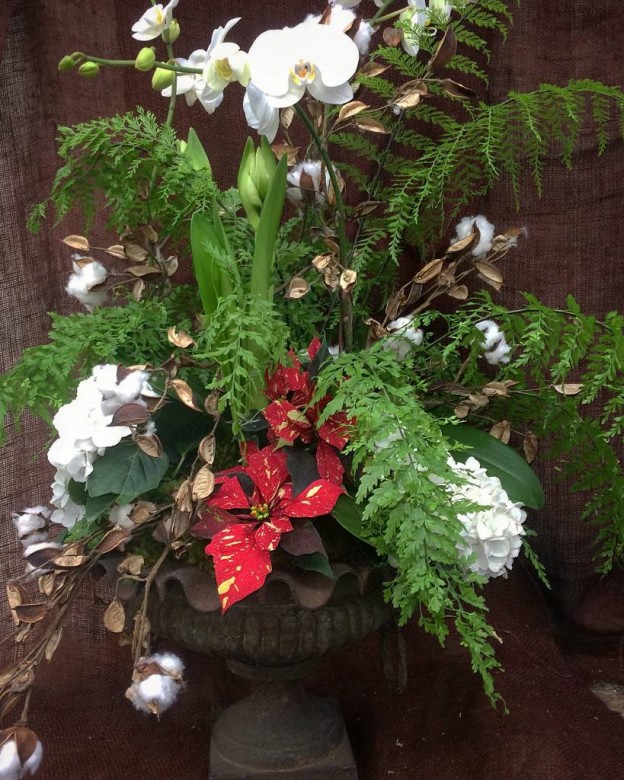
New Year’s Day…A Look Back And Wishes For The New Year
It’s a quiet, rainy morning as I write this, too chilly to make my usual morning walk around the garden. The time the shop is closed between Christmas and New Year’s Day is a welcome respite from the previous month’s hectic pace. It’s such a relief to be still and have no demands, if only briefly.
I’m looking forward to the new year, and soon I’ll be writing of primroses and spring flowers…the ones that our growers magically produce for greenhouses much earlier than in nature – blooming daffodils, tulips, crocus and more.
Today, though, I’m thinking of the holidays just past, when winter white azaleas, calla lilies, hydrangeas, paperwhites, larger than life blooms of amaryllis in every color, jewel-toned cyclamen, traditional poinsettias, and all the most wonderful orchids on dazzling display turned the greenhouse into a wonderland.
I hope these pictures bring a smile at the start of this new year. The artful combination of plants, branches, textural mosses (and other happy discoveries), are our resolution for the coming year. Here’s to beauty and creativity in 2016!
While these designs are mostly mine, Jamie’s, and Molly’s, I’d be remiss not to mention that many more were created by Pinkie, Danielle, and Angie – worthy of a future post!
By Kris Blevons
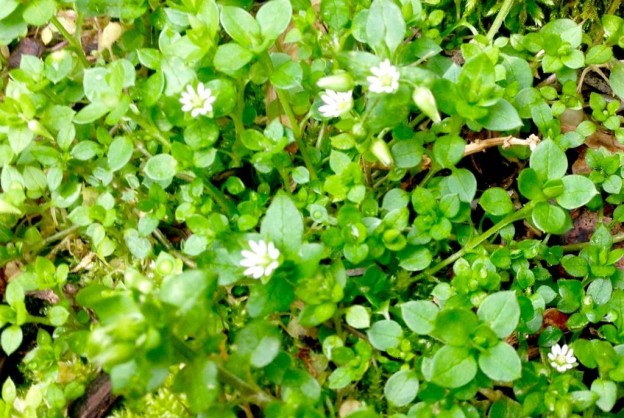
Chickweed – Don’t Let It Smother Your Spring Garden!
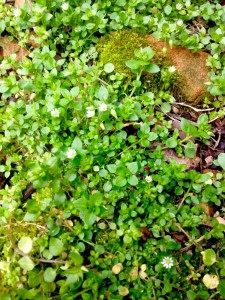 Chickweed, Stellaria media, is one of those weeds that isn’t there until, seemingly overnight, it’s everywhere in garden beds and lawns. A winter weed, cooler weather is conducive to its rapid growth. Where I find it most annoying is its rapid spread in flower beds of pansies and other cool season annuals. Fortunately, because it’s a winter weed, it’s usually gone by June with the onset of summer’s heat.
Chickweed, Stellaria media, is one of those weeds that isn’t there until, seemingly overnight, it’s everywhere in garden beds and lawns. A winter weed, cooler weather is conducive to its rapid growth. Where I find it most annoying is its rapid spread in flower beds of pansies and other cool season annuals. Fortunately, because it’s a winter weed, it’s usually gone by June with the onset of summer’s heat.
Chickweed has tiny, white, starburst shaped flowers that open on sunny days. Each plant produces thousands of seeds that can sprout immediately in warm weather and can remain viable in soil up to ten years.
If seeds are too deep in the soil they won’t germinate, but, when they’re close to the soil surface, they will germinate readily and grow very quickly in cool, wet conditions. Applying a pre-emerge weed killer to lawn areas in September will help keep this out of your grass. But if you still spot it’s light green leaves in your winter tan lawn, mowing before it goes to seed will help control it.
I hand weed it out of my flower beds, taking care to throw everything I pull into a garbage bag since any stray piece left in the bed will root, causing more work…
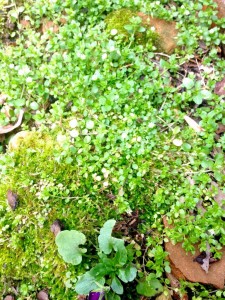
Chickweed’s common name is appropriate because it’s a favorite food of chicks that eat the leaves and seeds. This could be a good reason to get some chickens! It’s also edible if any of you are so inclined, or you can leave it for the birds and rabbits, who also like it. Now that I think about it, next time I’m weeding it out of my flower beds, maybe I should save some to try in a salad!
For even more details on chickweed, take a look HERE at a Penn State weed management post.
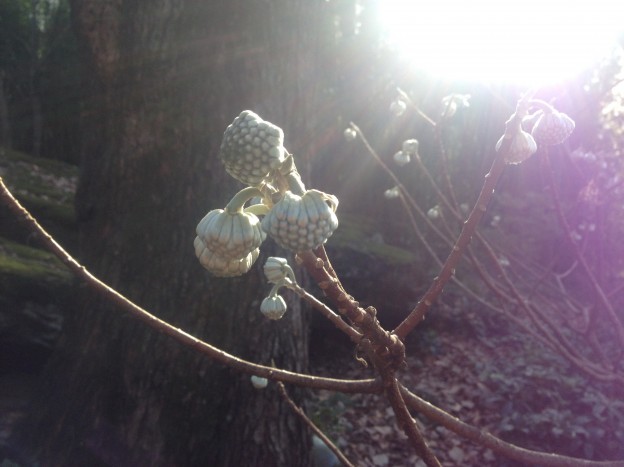
A Winter Walk Through A Southern Garden – One Year to the Next

At first glance, it doesn’t look like much is going on…
The garden looked hunkered down and frozen the other day, and well it should, since 10 degrees was a mite chilly for Birmingham, Alabama.
While gardeners in northern climes take the winter off, perusing catalogues and dreaming of a new garden season still months away, usually we in the south, like it or not, don’t have any real down time. I seem to spend much of mine walking through the garden and simply observing and thinking about what needs doing, and, when the temperatures drop down below freezing, I’m more than happy to stay inside.
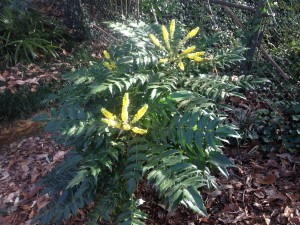
Mahonia ‘Charity’, adding it’s winter color…
For example, I’ve been thinking on and off for over a year now about moving one of the shrub roses from the front bed to the side of the driveway but haven’t quite gotten past the thinking stage yet. I’ve become much more relaxed about things; everything will get done in its own time. Don’t sweat the small stuff, right?
Here’s a bit from a post written last winter with some additional notes about what differences a year can make.
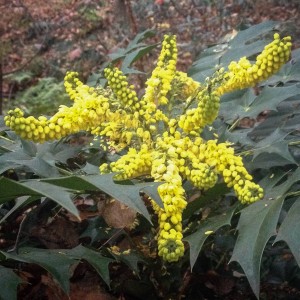
The mahonia, a year later, January, 2015
I see the Mahonia x media ‘Charity’ shrub that’s planted in a very shady spot is blooming. The birds love the blue/purple berries that follow the bright yellow flowers, and we don’t see the pretty fruit for long. I cut it back quite hard last spring because it was getting leggy. It’s fuller as a result this year, and next year will have even more blooms. (A note: This year, 2015, there are more blooms, and they’re bigger too!)
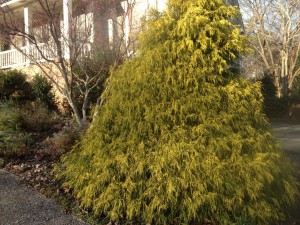
Chamaecyparis obtusa selections are wonderful for the south…
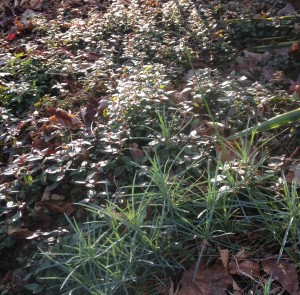
Groundcovers… Veronica ‘Georgia Blue’ and a dianthus…
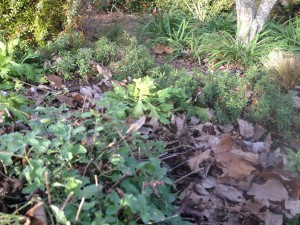
Candytuft, catmint, poppies…
Chamaecyparis obtusa ‘Golden Mop’ calls attention to itself out front with some yellow brightness of its own, anchoring the end of the front bed. It has loved this hot, sunny spot, and I appreciate being able to clip it for my holiday decorations. What a beautiful workhorse in the garden! I purchased it (and most of my shrubs and trees) in small pots and have let them grow into their spaces.
More subtle things are happening out front too. The early blooming evergreen groundcover Iberis, or candytuft, is showing its buds, and some are even opening. They evidently don’t look at a calendar or gardening book to tell them when they’re supposed to be blooming! (Update for 2015: definitely not as pretty as last year, but there’s still a smattering of bloom here and there.)
The veronica ‘Georgia Blue’, a white pass-along dianthus, and poppies seem happy, as does the catmint, ‘Walker’s Low’. The beautiful veronica will be covered with tiny blue flowers in late January into February, just as the poppies begin to fatten up and the violas begin to show more color. If you haven’t planted poppies, pansies, violas, the ‘Georgia Blue’ veronica or candytuft yet, it’s not too late to find a few spots for some. They’ll add some extra and welcome color in your yard this spring.
This bed will look much different in future weeks and months, but now, in the midst of winter, things are quiet…I must remember this is the season for patience.
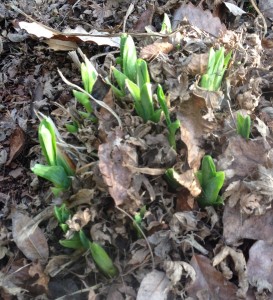
daylily foliage…
Some daylilys, though, are pushing out new green growth in this warm south facing bed; winter barely keeps them down. A large prostrate rosemary, another that loves this hot spot, is blooming pretty purply blue flowers that the bees adore. (This Rosemary really took a hit during the second snow event of 2014 – I ended up pulling it out early in the summer since it looked absolutely awful.)
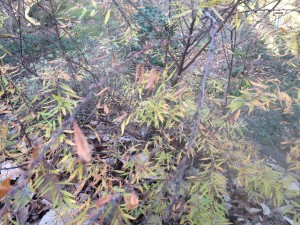
Spiraea ‘Ogon’
My route has taken me again to the back, where the Spiraea ‘Ogon’ is holding on to its few remaining willowy leaves, and, looking closely, I can see all the little buds along the stem. These will result in pretty white blooms in beautiful contrast with chartreuse new growth this spring. (this year – no leaves, hoping it blooms as well as last year.)
I walk down another level and there’s one of many small Alabama crotons, looking a bit bedraggled, still with a few silver backed orange leaves. The crotons love this part of my garden – thankfully, since it’s on a rocky slope with great drainage that they prefer.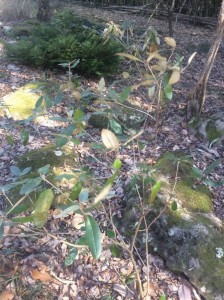
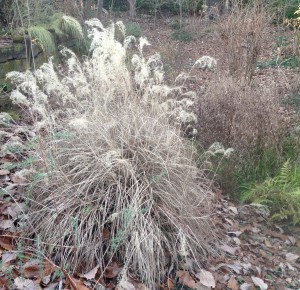
sun shining through a miscanthus…
Farther on, the plumes of a miscanthus show off in the afternoon light. This year, 2015, it looks so sad I won’t hesitate cutting it back next month. This will also keep all those seeds from wanting to sprout here and there. My Midwestern soul loves grasses… but not everywhere!
I notice this year that the pieris is fat and full of buds – the cold doesn’t seem to have affected it at all, at least I hope it hasn’t. It may be in a favorable microclimate – warmed by the rock outcrop just behind it, and the water below.
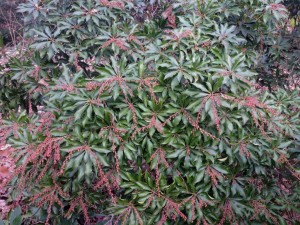
The Japanese pieris is full of buds…
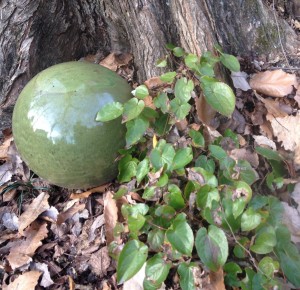
epimedium spreads slowly…
I make my way across the water and toward the rocks where an epimedium resides in the shelter and shade of a large elm.
I’ll be trimming it’s tattered winter foliage soon in anticipation of the dainty orange flowers that will appear early spring. There is no procrastinating with epimedium; if I wait too long to clean up those tattered leaves, I risk cutting the delicate stems the flowers arise on. These small lessons are often learned by doing the wrong thing at least once. I love all the different epimediums I’ve amassed over the years. They are slow growing, tough shade groundcovers – some evergreen, some not, and all very beautiful, even without flowers!
(Unfortunately the summer of 2014 a woodchuck created some serious mayhem in the garden, eating all the buds of the epimedium and the blue woodland phlox as well. It was so disappointing! I’m hoping this spring is better.)
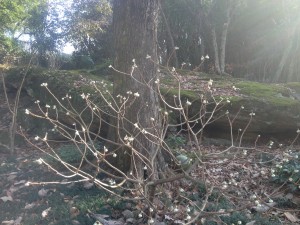
Edgeworthia chrysantha…
One shrub I never prune but let have it’s way, and that always blooms in the winter is the Edgeworthia chrysantha, or paper bush. I see the beautiful buds that have been getting larger all fall; soon they’ll begin to open and their incredible scent will fill the garden. It’s a true gem, holding interest in all the seasons, from it’s long lasting pretty buds to fragrant blooms, interesting bark, and big, bold leaves.

January, 2015
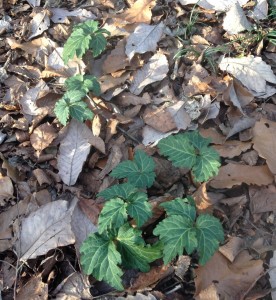
Native cardamine…
I need to end this post soon…Oh, but here, coming up through fallen leaves, is the Cardamine diphylla. I have this native in many spots under the shade of large trees. It will sport pretty white blooms on tall stems in late spring, but it’s the winter when the foliage is at it’s prettiest. By summer it will have retreated below ground once again. This winter it’s spread even more, and the pretty green foliage really stands out against the brown leaves beneath it.
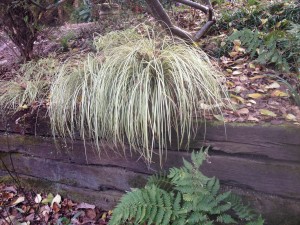
Carex ‘Evergold’
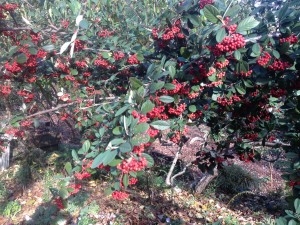
Parney’s clusterberry cotoneaster…the cedar wax wings will devour these berries in another few weeks!
Carex is another favorite, and here is Carex ‘Evergold’, spilling from a planter. Look how bright is is in the shade of a Cotoneaster lacteus – ‘Parney’s Clusterberry.
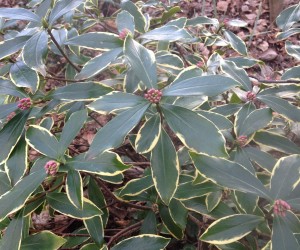
Oh so fragrant…daphne odora
Finally, the daphne odora’s pink buds are getting larger, and soon they’ll open, adding their incredible scent to the whole back garden. This is one that I leave well alone – it needs perfect drainage, and on this slope it seems to be happy. Too much coddling and they are prone to up and dying. So far I’ve been lucky with this one.
The light is beginning to fade and there’s a definite chill in the air; it’s time to go in. There will certainly be more ups and downs with our weather this winter – that’s a given. Finally, though, temperatures will gradually begin to rise as we make our way toward spring, and each day there will be more to see. I’m ready.
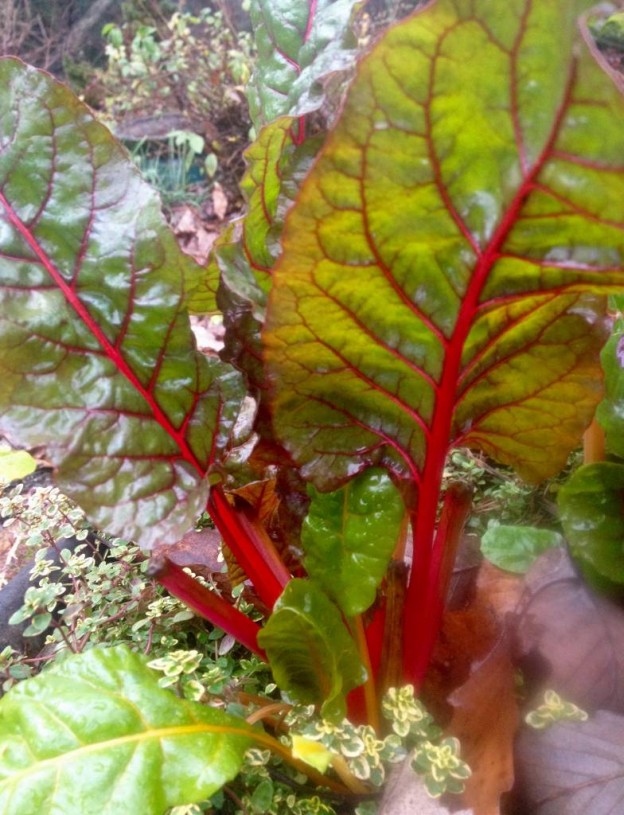
The ‘Better Late Than Never Garden’ – A Winter Update
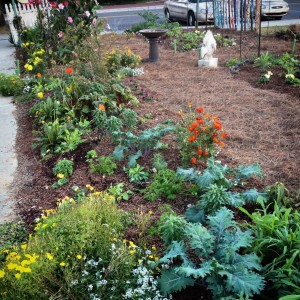
Tucking in winter plants around fall annuals, late fall…
The ‘better late than never garden’ is certainly living up to its name, since it was planted at the beginning of November 2014, and most of it finished just prior to the hectic holiday season, a full month later than I would have liked. This ‘better late than never’ schedule is working out okay so far, though, as the plants are growing steadily. Of course, more updates will follow, documenting successes and the inevitable failures that every garden and gardener has.
Most of these pictures were taken quickly very early on a mid-December morning in the middle of the holiday rush. Since there were other things that needed to be done, I couldn’t linger; but now, with the new year and more time, here’s an overview of the planting process and selection in this ‘better late than never’ winter garden.

Mid-December. Mulched and growing…
Let me admit right off that I’m not a “garden designer”. I can’t tell you that I drew a beautiful rendering of what I envisioned this garden to be come spring. No, the reality is that I grabbed a few packs of this and a few pots of that (usually in the middle of a busy day), raced across the street trowel and plants in hand, and plugged them in wherever I felt they worked best. So, in that way, little by little and over and over, the garden was planted. Time, attention, and the weather will determine how it turns out this spring.
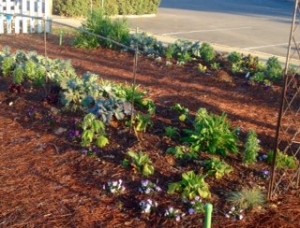
Violas, delphinium, poppies, kale, curly parsley, bachelor buttons and more growing… Mid-December
I began by planting a few foxglove, delphinium, and bachelor buttons under the still blooming summer tithonia. Then, when it was finally pulled out (Better late than never too!), pansies, violas, and sweet alyssum were added to large spaces that opened up.
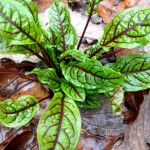
Red Veined Sorrel, Rumex sanguinea, in the winter garden…January
Since the summer annuals were pulled out of them first, the two front beds were planted the earliest with snapdragons, poppies, bachelor buttons, chard, curly parsley, dill (The dill will eventually freeze at some point.), red veined sorrel, ‘Bull’s Blood‘ beets, kale, and mustard “Red Giant“. There’s quite a mix of annuals, herbs, flowers, and even bulbs (dwarf narcissus and ipheion) in each bed.
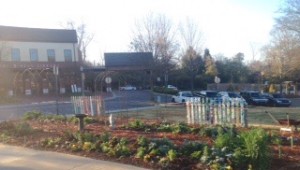
The ‘better late than never garden’ in mid-December…
A good layer of mulch is really important for your winter garden. Some folks start with a completely empty bed, add the mulch, then plant through it, a great method and easy to do. Of course, I did just the opposite. I had the time to plant before I had the help for the mulch! So, inevitably, there I was, mulching in the dark before the first cold snap of the season.
I also made sure everything was watered well before spreading the shredded pine bark around the little plants. There will be many more cold snaps before the winter is through, and I’m counting on this mulch to keep the soil warm since this isn’t a garden that gets babied.
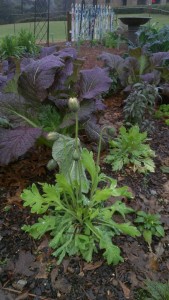
A poppy, in bud, with ‘Red Giant’ ornamental mustard in the ‘better late than never garden’ in January…
For people that don’t have big blocks of time (That’s most of us, I think.), planting a little bit at a time does work…obviously I’m a poster child for it. Now I’m concentrating on keeping winter weeds controlled in the beds, since the two worst offenders, chickweed and henbit, insist on coming up. Don’t let these winter weeds get hold in your garden. Pulling a few every week is far more preferable than tackling them come spring, after they’ve been allowed to smother your pansies and violas.
Have you planted some flowers for spring? If you haven’t, try a few poppies, pansies, or violas since, as you know now, it’s never too late to plant a garden. I’ll keep you posted on our ‘better late than never’ garden’s progress too!
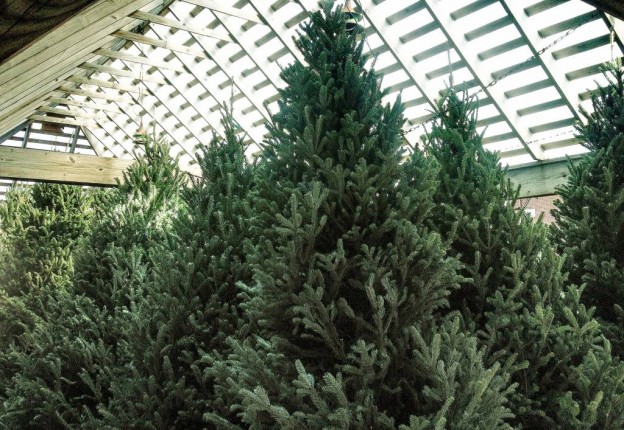
First, the Christmas Trees Arrive…

Sugar Pinecones…
 I know the holiday season is here when the greenery bunches, garlands and wreaths we’ve ordered begin to appear – not to mention fragrant Fraser fir Christmas trees. I was looking forward to two of the boxes in particular this year – the ones the huge sugar pine cones were packed in, just 30 to a box because they’re so big.
I know the holiday season is here when the greenery bunches, garlands and wreaths we’ve ordered begin to appear – not to mention fragrant Fraser fir Christmas trees. I was looking forward to two of the boxes in particular this year – the ones the huge sugar pine cones were packed in, just 30 to a box because they’re so big.

Ribbon and Greenery added to a Sugar Pinecone…
Take a look in any craft magazine or on Pinterest and you’ll find plenty of decorating being done with these Northwest beauties! There hasn’t been much time for us to play with these big pinecones, but I was able to add a bit of ribbon and some greenery to a couple before it got too busy. A beautiful collection of these impressive cones in a large basket, with a bit of reindeer moss tucked between and curls of ribbon for more color, would be festive too.
There’s a definite progression of the holiday season that I’ve noticed over the many years in this business, and, for no other reason than I’ve observed this phenomenon, here it is:

Alabama Cryptomeria Wreaths…
First the Christmas trees, outdoor garlands, and wreaths arrive, bringing the scent of the Carolina mountains to Birmingham. The trees are the stars of the show for a couple of weeks, and the buzz of tree drills and saws fill the air.

Families arrive to find their perfect tree among the 700 that are drilled for our tree stands and given a fresh cut before they’re moved out for sale. Bows for wreaths and other outdoor decorations are debated and chosen, and mailbox decorations are ordered.
Slowly but surely the outdoor decisions are made, trees are delivered, and festive decorations for inside and outdoors are complete. Now the emphasis shifts to the greenhouse, a magical place during Christmas, full of pretty flowering plants and more, and we begin the party season. Containers fill the back design area, waiting to be transformed into beautiful arrangements ready on just the right date. Finally, closest to Christmas, teacher’s gifts and gifts for family are arranged, to be picked up just before the end of school or prior to leaving town.

Finished Arrangements…

Our Grinch…
In fact, this year we had to make more room for finished pieces in front of the design area. Our new area has worked out well, since now it’s easier for everyone to see many of the finished centerpieces, pots, and special orders, and it gives people ideas for their own gifts or containers.

There’s another new addition this year too. Tacca, our garden shop cat, is experiencing her first holiday season and is she enjoying it! She’s taken to sitting in our Christmas display, right in the line of sight of all the children, who come in to pet her while they look at Santa and his elves. This year Molly created our wonderful grinch too.
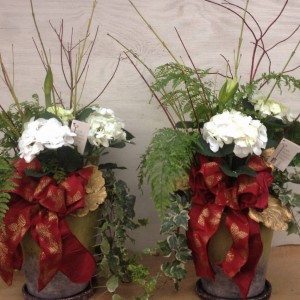
More Arrangements…
While Fraser fir scents fill the outside nursery, the greenhouse is truly a feast for the senses too, filled with colorful flowers and lights.
Here you’ll find orchids, amaryllis, jasmine, stephonotis, hydrangeas, rieger begonias and more, including the usual poinsettias. There’s really nothing like a true greenhouse, devoted almost entirely to plants of the season. Box stores with their fluorescent lights and a few holiday plants simply can’t compare. I hope you’ll come visit and see why.

Fall Favorites For Spring Flowers…A Primer On Pansies & Violas

Pansy Matrix Ocean Breeze MIx
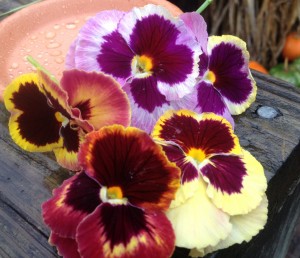
Pansy Matrix Sunrise
Fall is planting time here in Birmingham, and pansies and violas are the stars of the show. Even if folks plant nothing else, it’s so easy to put a few of these spring beauties in a little spot in the garden, a pot, or a window box for the winter.
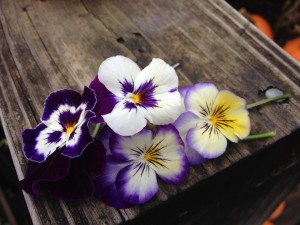
Panola Purple Face & Viola Sorbet Blueberry Cream
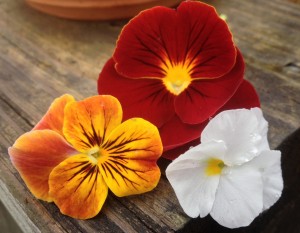
Pansy Dynamite Scarlet/Viola Sorbet Antique Shades/Viola Penny White
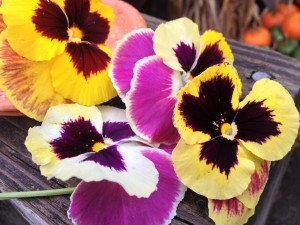
Pansy Majestic Giants Patricia
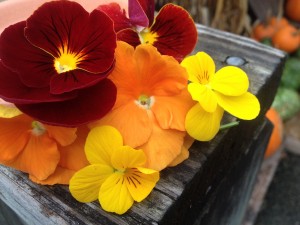
Pansy Dynamite Scarlet/Pansy Matrix Orange/Viola Sorbet Yellow
Oh but what a dizzying selection greets you at the garden shop! Tables upon tables of blooms…some diminutive, others large, some with solid colors, others with charming “faces”, all waiting for you to decide which of them to choose to add beauty to your landscape next spring – and even some color through the winter.
One rainy Saturday morning I put together a few sample combinations of pansies, violas, and mixtures of the two to show you a few options available for your planting pleasure…but keep in mind this is just the tip of the iceburg when it comes to playing with color in your garden!
Remember to think about what else will be blooming in your garden come spring. You may not want a pink pansy in front of your orange azaleas (Though I’ve been known to favor pink and orange in certain instances!), so think it through before you decide.
Another consideration to keep in mind is the color of your house. My first summer in our home I decided I wanted an “English Garden” look out front, using pinks/purples and silvers.
I was so caught up in my vision that I forgot this color palette would look like blech in front of the brick – I was unhappy with it all summer and couldn’t wait to tear it all out come fall.
Now I use brighter colors and include poppies – it looks so much better! I save the more muted colors for the back of my house where I play with my “English Garden” and plant everything I want to – including foxglove and snapdragons for spring interspersed with pansies and violas.
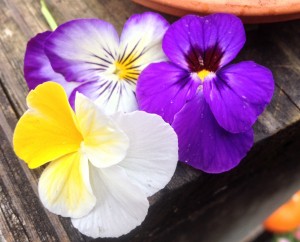
Viola Sorbet Purple Duet/Blue Blotch/Banana Cream
The difference between a pansy and a viola is primarily size and shade tolerance. The pansy bloom and plant is larger. Pansies need at least half a day of sun to bloom well; full sun all day is best, but remember, in the spring as the temperatures rise, they’ll play out faster in so much sun.
Violas are smaller in size and the blooms are smaller as well. However, violas put out massive amounts of small blooms and the plants attain a nice rounded size which makes up for those diminutive flowers. Violas can tolerate less sun, though, as with the pansies, at least half a day sun is best.
As for most plants, fertilizing is important. Plant Tone is a good natural (and stinky!) amendment to add to beds in the fall. Incorporate it with a first feeding of Osmocote, which will release its nutrients until the soil gets cold.
Mid-winter apply calcium nitrate to add extra nitrogen. After planting, always water your plants in and apply a good layer of mulch to keep roots warm through cold spells.While plants are blooming be sure to deadhead, (pinch off faded blooms) to keep more buds coming. If you leave old blooms on to die then set seed, this creates a messy looking plant that’s putting all its energy into that seed, not into future blooms.
This is especially important to remember come spring. Don’t be overly concerned if plants aren’t blooming in the middle of winter. This is normal – especially if we have cool, frosty nights. Remember, the real reward comes in the spring!

Pansy Mariposa Peach Shades
Be mindful of winter temperatures – this is the time to watch the weather reports each morning or evening. Pansies are tough plants, but help them out by making sure soil in beds or planters is moist if there are freezing temperatures forecast.
Hopefully these suggestions and tips will be helpful for any of you that get overwhelmed by the choices available…happy planting!
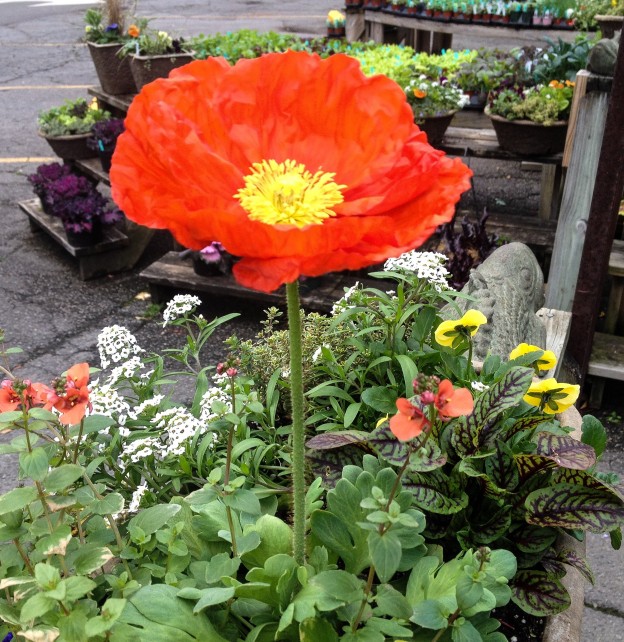
Poppies! Plant Some This Fall!
I love poppies. Specifically, papaver nudicaule, or Iceland poppies, bright harbingers of spring in the Birmingham area.
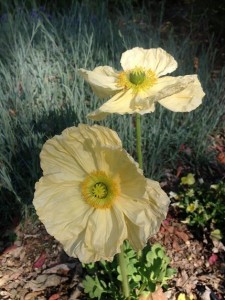 Best planted in the garden in a sunny spot that won’t stay too wet, they’ll grow through the winter getting bigger and bigger. The first fat bud uncurling signals spring isn’t far off, and once they begin to bloom they continue, until, finally, they fade in the true heat of late spring.
Best planted in the garden in a sunny spot that won’t stay too wet, they’ll grow through the winter getting bigger and bigger. The first fat bud uncurling signals spring isn’t far off, and once they begin to bloom they continue, until, finally, they fade in the true heat of late spring.
Most people are skeptical when I go on about poppies – until they try them. (I admit I’ve had to work hard to talk some of you into planting them, they look so scrawny and pitiful in their little cell packs or 4″ pots.)
Poppy Care:
Plant them in a sunny, well drained spot.
When you remove them from their pots, disturb the root ball as little as possible. I know, this is contrary to what you’ve always heard about planting. But, trust me on this, poppies don’t like their roots messed with.
Don’t plant too deeply. Water them in after planting, then allow them to dry out between watering. Do not overwater!
When they begin to bloom, deadhead, or cut off faded blooms. This will ensure the energy of the plant will go toward producing more bright flowers, not a poppy seed pod.
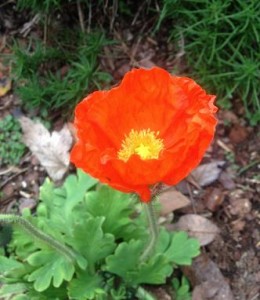 Cut some to bring inside! Here are some tips for cutting your poppy blooms:
Cut some to bring inside! Here are some tips for cutting your poppy blooms:
– Wear gloves. Poppies secrete a liquid that can irritate the skin.
– Cut stems early in the morning when the most moisture is in the stem. The best stage to cut your poppy is when the bud is just beginning to stand up straight and is slightly colored.
– Cut the stem with a sharp pair of scissors so the stem doesn’t flatten or get squished.
– Sear the cut end of the stem with a match or dip it in boiling water to seal it. This will keep the moisture in the stem and help the flowers last as long as possible.
– Place your stems in cold water before moving them to their place of honor in your home or as a bright gift for a friend!
Poppies…one more in a long line of beautiful flowers for the spring garden. Don’t miss out this year – find a sunny spot and plant a few!
By Kris Blevons
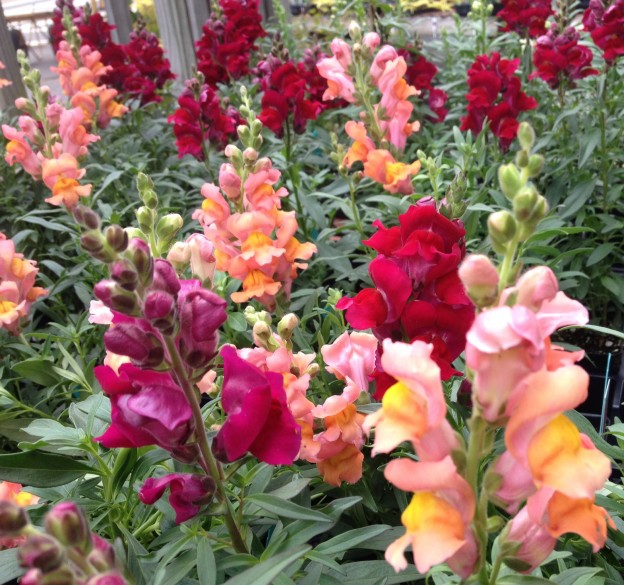
Snapdragons – Plant This Fall for Cut Flowers Next Spring!
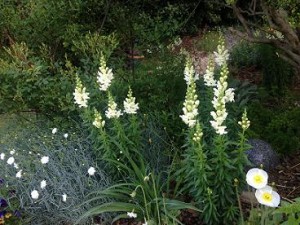
snapdragons, poppies and a pass-a-long white dianthus…
Snapdragons! These childhood favorites certainly deserve a space in our spring gardens. Planted in the fall, these annuals will survive a normal Birmingham winter and give us glorious springtime color.
I’ve discovered that since their bloom time always seems to come after the pansies and violas have begun to fade in the late spring heat, that placing them in garden beds intermingled with perennials, roses and poppies is the best way to enjoy them. There’s simply nothing like a spring garden with snapdragons in it – and they are beautiful cut flowers too!
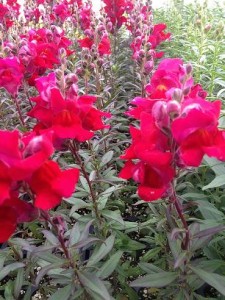 Snapdragons can be purchased in the fall in cell pack flats and in larger pots as well. Many times they’ll be in bloom. When theses initial bloom spikes are finished, cut them back below the faded flowers. This will ensure they’ll branch and be fuller and more robust. Through the winter the plant’s energy will go into growing roots and strong leaves – the beautiful blooms next spring are your reward!
Snapdragons can be purchased in the fall in cell pack flats and in larger pots as well. Many times they’ll be in bloom. When theses initial bloom spikes are finished, cut them back below the faded flowers. This will ensure they’ll branch and be fuller and more robust. Through the winter the plant’s energy will go into growing roots and strong leaves – the beautiful blooms next spring are your reward!
Be careful not to overwater your snapdragons, especially very young, newly transplanted ones. Let them dry out a bit between watering since their root systems can easily be overwatered at this stage and will not recover from it. If they have been overwatered, the plant will wilt, looking for all the world like it needs water. If, after being given some, your snapdragons continue to look droopy, it’s best to pull them out and try again with fresh plants.
By Kris Blevons
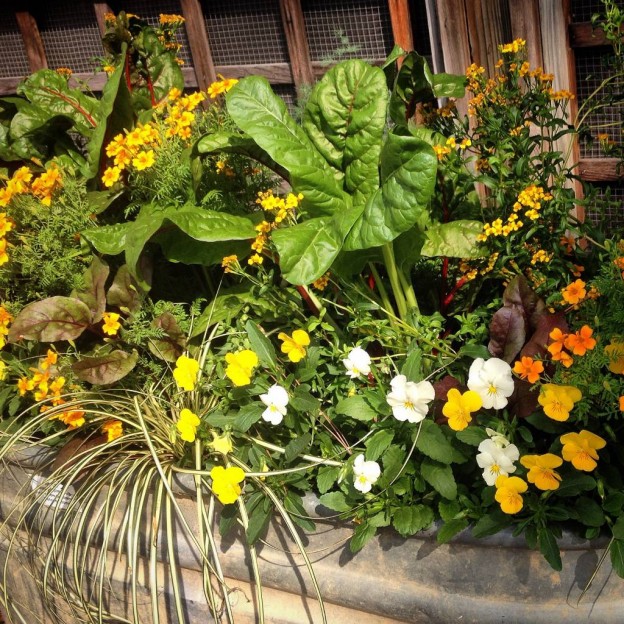
Fall flowers…Pansies and More!
We’re so lucky in Birmingham to be able to plan and plant our winter and early spring gardens in the fall, using fresh annuals, like the colorful pansies and violas, as well as various vegetables – ornamental and edible kale, cabbage, and pac choi are just a few. With summer’s heat behind us, time spent in the garden is a pleasure, not a chore.
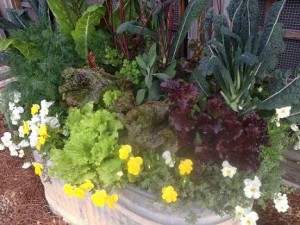
Soon all the tables in the nursery will be laden with plants of all kinds – this is such a great opportunity for you to create the most beautiful early spring garden!
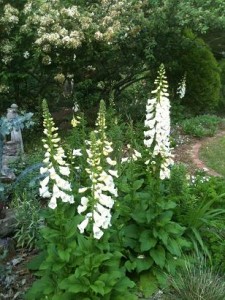 Start with pansies and violas for beds and planters, then add supporting players. Some of the prettiest additions to your winter/early spring garden are foxglove with their tall spires of white, pink and purple, snapdragons – they are worth waiting for – poppies, with their bright orange, yellow, red and white papery blooms, and the bluest blue bachelor buttons.
Start with pansies and violas for beds and planters, then add supporting players. Some of the prettiest additions to your winter/early spring garden are foxglove with their tall spires of white, pink and purple, snapdragons – they are worth waiting for – poppies, with their bright orange, yellow, red and white papery blooms, and the bluest blue bachelor buttons.
There are so many leafy greens to interplant in containers and beds too – colorful chard, kale and mustard are so beautiful and edible as well. Curly parsley is another staple of the winter garden, adding its rich green leaves and texture to any composition.
Finally, don’t overlook the unassuming fall bulbs. Planting a bulb is a leap of faith for some, while other folks plant a few every year to add to their spring display. It’s truly amazing that such beauty lies in something so seemingly drab.
Smart gardeners know to look for all of these in the fall, planting them in anticipation of a gorgeous spring display!
Fall Planting Tips To Create A Great Spring Garden:
-
Amend your soil. You might think since you followed our advice and added soil conditioner, PlantTone, cow manure or compost to your beds last spring you’re done. Not so fast! High temperatures break down soil amendments quickly, and plants take up nutrients. Continue adding to your soil every season. Healthy, loose soils create healthy plants. (Instead of putting fallen leaves to the curb, start a compost pile with them, or run over them with your lawn mower and throw them in your beds. They’ll decompose and add to your soil’s structure and health.)
- After you get your plants home, be sure to keep them watered, especially if you can’t plant them right away. We water small transplants in 4″ pots and cell packs at least once a day, especially if it’s hot and sunny. Of course, less water is required in cloudy, cool conditions. Right before you plant them, be sure they’re moist.
- Early in the season while the soil is still warm, you can still plant with Osmocote. However, later in the winter months, use Calcium Nitrate to feed your plants, especially if the foliage of your pansies turns a reddish color. Remember, you’re planting for spring color, though on warm days through the winter you should also have some blooms.
- Water your bed thoroughly after planting, and keep it watered while your transplants are getting their feet settled in their new home. Take care not to overwater, though, especially as the temperatures cool down going into the winter months.
- Mulch your beds with shredded mulch or pine straw to keep soil temperature around the roots as warm as possible.
- Deadhead your pansies and violas! I can’t stress enough how important this is. A pansy that you leave a dead bloom on will form a seed there, instead of putting that energy into more flowers. Make a practice to walk through your garden at least once a week, taking a good look at your plants and deadheading faded blooms. If you’ve missed some, you’ll see the seed pod beginning to form. Pinch any and all off! This will go a long way toward keeping your pansies happy!
– Posted using BlogPress from my iPhone
March Brings New Shrubbery, Vines and Herbs…
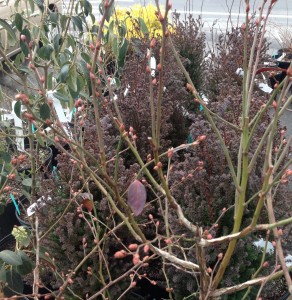
Unloaded in the parking lot…
It’s the beginning of March, and finally (!) the nursery looks like more than an empty parking lot. A sure sign that spring is approaching are the first shipments of shrubbery, early perennials, and herbs, including a couple of different spiraeas, snowball viburnum, Deutzia ‘Nikko’, blueberry bushes, and ‘Red Star’ and ‘Golden Mop’ evergreen chamaecyparis.
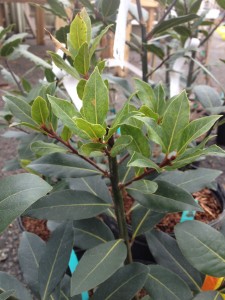
Bay laurel
If your bay laurel, rosemary or confederate jasmine succumbed to this winter’s frigid temperatures, we have some of all of these too. Unfortunately many of us have to replace them this year. The ‘Tuscan Blue’ rosemary is in one gallon pots – a good size to plant now.

Confederate jasmine, shown here with a clematis growing through it…
This shipment also brought Virgninia Sweetspire, Itea virginica. A great shrub for our area, it is adaptable to many situations and provides spring blooms and beautiful fall color as well.
In addition to the confederate jasmine, another flowering vine, the beautiful (and non-invasive) honeysuckle, Lonicera ‘Alabama Crimson’, is in stock now too. It’s blooms are honey for hummingbirds as they repopulate our area for the summer.
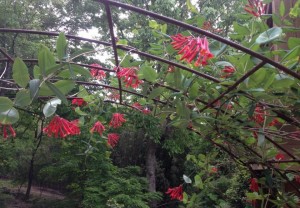
‘Alabama Crimson’ honeysuckle, growing on my arbor
This first shipment is just the beginning of the rebirth of the nursery for a new season of gardening. More and more will arrive until, finally, we’ll be oveflowing again with green and flowering goodness…stay tuned!
Why Shopping For Plants At A Locally Owned Independent Should Matter To You
This January our winter temperatures dropped lower than they’ve been in two decades. While uncomfortable, this is actually good for easing the summer bug population (Ticks, mosquitoes and fleas come to mind.). But it does put a damper on gardening efforts, though dormant trees, shrubs and perennials can still be planted and bright pansies added to planters and garden beds carry us into spring.
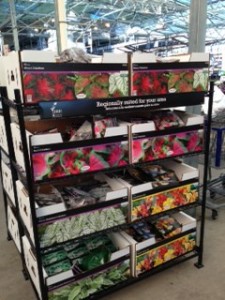 However, a friend recently sent a picture she took (mid January) of warm weather caladium bulbs that had been left outside on display racks for sale in freezing temperatures at one of the “big box” stores in town. Now, caladiums grown in pots are so heat loving we don’t even begin to carry them until late April – and advise people not to plant caladium bulbs in the ground until the soil is thoroughly warmed in May.
However, a friend recently sent a picture she took (mid January) of warm weather caladium bulbs that had been left outside on display racks for sale in freezing temperatures at one of the “big box” stores in town. Now, caladiums grown in pots are so heat loving we don’t even begin to carry them until late April – and advise people not to plant caladium bulbs in the ground until the soil is thoroughly warmed in May.

Caladiums in the summer garden – they love the heat…
Why should this matter to you? Because, if you weren’t aware of this, you or your neighbor might have bought these and, on the next warm, sunny day, planted them. Of course, after having been left outside on the racks in those temperatures, your gardening failure is guaranteed since the bulbs were not properly taken care of. It’s highly questionable whether they should even be for sale yet – unless they think someone will purchase them to start inside in pots and plant them outside at the proper time (May, remember?).
This is just one example of why shopping for your plants with people who sell only plants, at locally owned, independent garden shops, matters. Thanks for reading.
Interesting Late Winter Arrangements…

 Now that January is behind us, we can look forward to spring, knowing it is right around the corner. Until then, we’ve been satisfying our planting urges using late winter offerings from growers. We are determined to come up with something interesting on long winter days in the greenhouse!
Now that January is behind us, we can look forward to spring, knowing it is right around the corner. Until then, we’ve been satisfying our planting urges using late winter offerings from growers. We are determined to come up with something interesting on long winter days in the greenhouse!
Jamie found some wonderful lichen covered branches; they’re beautiful to work with. She positioned them on one of our cork pieces and planted around them, creating a visual feast of winter flowers – cyclamen, primroses, muscari, osteospermum and teté a teté narcissus – for a customer. The bright flowers of this piece and the addition of some ceramic mushrooms make it memorable!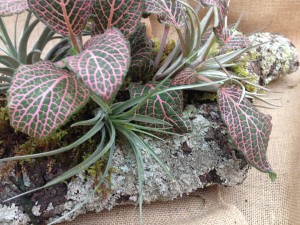
I wired one large lichen covered branch that had an interesting shape to one a bit smaller, using bark wire. I then lined the opening that was created with waterproof foil and sheet moss. In this “container” I planted a simple fittonia and air plant arrangement. The size and shape make this one a nice coffee table piece…and it would be very easy to care for too.
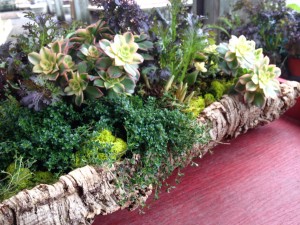
 Many of the succulent aeoniums fare better here during the winter months. They seem to dislike our excessive summer humidity (Don’t we all?), and the Aeonium ‘Kiwi’ seemed just right to work into some sort of arrangement. I loved how they looked paired with this frilly dark purple leaf ornamental mustard. If I could just work it into a container that could be moved in and out easily if temperatures dropped below freezing…
Many of the succulent aeoniums fare better here during the winter months. They seem to dislike our excessive summer humidity (Don’t we all?), and the Aeonium ‘Kiwi’ seemed just right to work into some sort of arrangement. I loved how they looked paired with this frilly dark purple leaf ornamental mustard. If I could just work it into a container that could be moved in and out easily if temperatures dropped below freezing…
I chose a cork bark piece that complimented the aeoniums and mustard. With the addition of some creeping thyme and a couple of pots of species crocus bulbs just beginning to come up, I think it turned out pretty well!
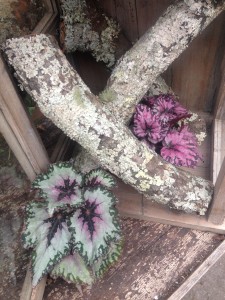
Lichen branches and rex begonias…
We have more of these lichen covered branches available, if you’d like to use some for an arrangement of your own, or we can put one together for you.
– Posted using BlogPress from my iPhone

More To See On A Winter’s Walk Through A Southern Garden
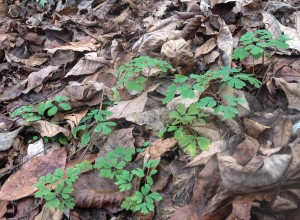
false rue anemone…

cyclamen hederifolium…
January is frigid in many parts of the country and can be a bleak month at best. But it’s also a good time to take a walk through your landscape, observing and planning. Here are some things I spotted on a short walk recently.

geranium ‘Biokovo’…
Native plants like false rue anemone, Enemion biturnatum, are beginning to show through the fallen leaves and promise pure white blooms this spring. Only the bloodroot is a purer white. The cyclamen hederifolium blooms are past, but the pretty mottled foliage is spreading. Here’s some under a native azalea. There are also crocus bulbs interplanted with these cyclamen that will be coming through the leaf litter soon.
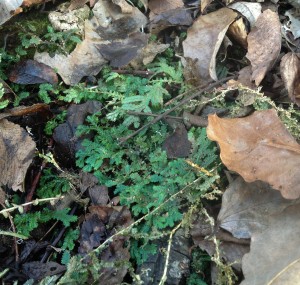
selaginella…
Perennial geraniums are good, tough plants too. Here the foliage of Geranium x cantabrigiense ‘Biokovo’, a cranesbill geranium, is looking quite happy along a rocky slope. It’s a pretty groundcover here and gets enough sun in this spot to bloom in the late spring. After the white flowers tinged with pink fade, I’ll clip it back to keep it tidy.

acorus variegata…
A little farther down the slope, and in more shade, is some selaginella uncinata, or peacock spikemoss. This groundcover is closely related to ferns and likes this shaded, moist spot. By midsummer, with enough moisture, it will be a lush, blue/green carpet underneath the trees and sheltered by the rock outcrop.
Below the rock outcrop, and along a dry riverbed, a spring provides water for evergreen acorus. In addition to Acorus ‘Ogon’, a yellow variegated form, here is the Acorus variegata, with a white variegation. Both of these love moisture, and they spread freely. In February these will get cut back at the same time the dwarf mondo is cut, making way for new, fresh growth.
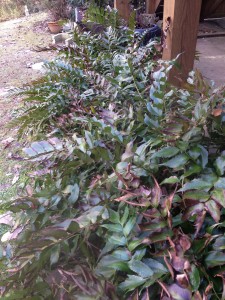
holly ferns…
Other plants that will need old, tattered, winter damaged fronds cut off next month are the perennial ferns, including tassel (polystichum polyblepharum), autumn (Drypteris erythrosora), and, shown here, holly ferns (Cyrtomium falcatum). Sure, they’re evergreen, but, by winter’s end, they definitely need cleaning up. Wait until at least the end of February to do any drastic cutting back, though, as the old foliage also helps protect the crown of the plants from cold temperatures.
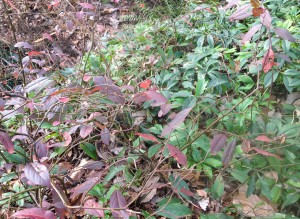 Above the water but spreading down the slope toward it, is a planting of Virginia sweetspire, Itea virginica ‘Henry’s Garnet’ , still holding the garnet colored fall foliage of its name. Underneath this spreading, suckering, shrub is another common evergreen perennial groundcover, the reliable Lenten roses, helleborus orientalis.
Above the water but spreading down the slope toward it, is a planting of Virginia sweetspire, Itea virginica ‘Henry’s Garnet’ , still holding the garnet colored fall foliage of its name. Underneath this spreading, suckering, shrub is another common evergreen perennial groundcover, the reliable Lenten roses, helleborus orientalis.
These two have gradually spread over the years, and the itea will also show off it’s dainty fragrant white blooms along arching stems this spring. It is truly an all season shrub, and the long lasting lenten roses blooming under them are good companions. Soon enough it will be time to clip off old, winter damaged leaves of the lenten roses, but not yet. January is the month to simply observe, taking time to enjoy a quiet walk through the garden on a sunny, chilly day.
A Winter Walk Through A Southern Garden

At first glance, it doesn’t look like much is going on…
It’s the day after Christmas, and I’m itching to get outside and see what’s been happening in my garden while I’ve been busy with the holidays at the shop. Leaving the house very early and getting home after dark doesn’t give a garden junkie like myself much time to play.
While gardeners in northern climes take the winter off, perusing catalogues and dreaming of a new garden season still months away, we in the south, like it or not, don’t have any real down time. But, since I seem to spend much of mine walking through the garden and simply observing and thinking about what needs doing, winter does seem a tad more relaxed.

Mahonia ‘Charity’, adding it’s winter color…
For example, I’ve been thinking on and off about moving one of the shrub roses from the front bed to the side of the driveway but haven’t quite gotten past the thinking stage yet. I’ve become much more relaxed about things; everything will get done in its own time. Don’t sweat the small stuff, right?
So, let’s take a little swing around the yard and take a look at what’s happening.
I see the Mahonia x media ‘Charity’ shrub that’s planted in a very shady spot is blooming. The birds love the blue/purple berries that follow the bright yellow flowers, and we don’t see the pretty fruit for long. I cut it back quite hard last spring because it was getting leggy. It’s fuller as a result this year, and next year will have even more blooms.

Chamaecyparis obtusa selections are wonderful for the south…

Groundcovers… Veronica ‘Georgia Blue’ and a dianthus…

Candytuft, catmint, poppies…
Out front, the Chamaecyparis obtusa ‘Golden Mop’ calls attention to itself with some yellow brightness of its own, anchoring the end of the front bed. It has loved this hot, sunny spot, and I appreciate being able to clip it for my holiday decorations. What a beautiful workhorse in the garden! I purchased it (and most of my shrubs and trees) in small pots and have let them grow into their spaces.
More subtle things are happening out front too. The early blooming evergreen groundcover Iberis, or candytuft, is showing its buds, and some are even opening. They evidently don’t look at a calendar or gardening book to tell them when they’re supposed to be blooming!
The veronica ‘Georgia Blue’, a white pass-a-long dianthus, and poppies seem happy, as does the catmint, ‘Walker’s Low’. The veronica will be covered with tiny blue flowers in late January into February, just as the poppies begin to fatten up and the violas begin to show more color.
This bed will look much different in future weeks and months, but now, in the midst of winter, things are quiet…I must remember this is the season for patience.

daylily foliage…
Some daylilys, though, are pushing out new green growth in this warm south facing bed; winter barely keeps them down. A large prostrate rosemary, another that loves this hot spot, is blooming pretty purply blue flowers that the bees adore.

Spiraea ‘Ogon’
My route has taken me again to the back, where the Spiraea ‘Ogon’ is holding on to its few remaining willowy leaves, and, looking closely, I can see all the little buds along the stem. These will result in pretty white blooms in beautiful contrast with chartreuse new growth this spring.
 I walk down another level and there’s one of many small Alabama crotons, looking a bit bedraggled, still with a few silver backed orange leaves. These crotons love this part of my garden on a rocky slope with great drainage.
I walk down another level and there’s one of many small Alabama crotons, looking a bit bedraggled, still with a few silver backed orange leaves. These crotons love this part of my garden on a rocky slope with great drainage.

sun shining through a miscanthus…
Farther on, the plumes of a miscanthus show off in the afternoon light. It will need cutting back next month to keep all those seeds from wanting to sprout here and there. My Midwestern soul loves grasses… but not everywhere!

epimedium spreads slowly…
I make my way across the water and toward the rocks where an epimedium resides in the shelter and shade of a large elm. I’ll be trimming it’s tattered winter foliage soon in anticipation of the dainty orange flowers that will appear early spring. There is no procrastinating with epimedium; if I wait too long to clean up those tattered leaves, I risk cutting the delicate stems the flowers arise on.
These small lessons are often learned by doing the wrong thing at least once. I love all the different epimediums I’ve amassed over the years. They are slow growing, tough shade groundcovers – some evergreen, some not, and all very beautiful.

Edgeworthia chrysantha…
One shrub I never prune but let have it’s way, is the Edgeworthia chrysantha, or paper bush. I see the beautiful buds that have been getting larger all fall; soon they’ll begin to open and their incredible scent will fill the garden. It’s a true gem, holding interest in all the seasons, from it’s long lasting pretty buds to fragrant blooms, interesting bark, and big, bold leaves.

Edgeworthia buds…

Native cardamine…
I need to end this post soon…Oh, but here, coming up through fallen leaves, is crinkle wort, Cardamine diphylla. I have this native in many spots under the shade of large trees. It will sport pretty white blooms on tall stems in late spring, but it’s the winter when the foliage is at it’s prettiest. By summer it will have retreated below ground once again.

Carex ‘Evergold’

Parney’s clusterberry cotoneaster…the cedar wax wings will devour these berries in another few weeks!
And here’s another favorite, Carex ‘Evergold’, spilling from a planter. Look how it adds it’s lightness under the shade of a Cotoneaster lacteus – ‘Parney’s Clusterberry.

Oh so fragrant…daphne odora
Finally, the daphne odora’s pink buds are getting larger, and soon they’ll open, adding their incredible scent to the whole back garden.
These walks always make me feel relaxed. Sure, I see things that need to be done, but usually I see so much more!
By Kris Blevons
Christmas Trees, Wreaths, And Greens – Fragrant And Beautiful!

The trees have arrived!
The day before Thanksgiving is the official start of the holiday season at Oak Street Garden Shop. Early in the morning the first of two flatbed semis arrive, bearing Fraser fir Christmas trees of all sizes, from the smallest tabletop trees for youngsters (and those young at heart!) to towering beauties for the grandest foyer.
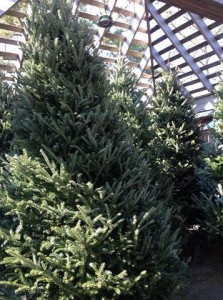
Christmas trees fill the nursery….
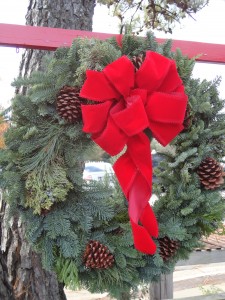
wreath from the west coast…
These trees (and the Fraser fir wreaths and garland that arrive from another favored supplier) come from the high elevations of the North Carolina mountains and make their way here to grace your homes through the holidays. Other greens – mixed wreaths, berries and branches – come from Oregon, beautiful mixtures of evergreens not found in the South.
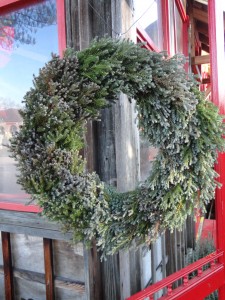
‘Red Star’ chamaecyparis southern wreath…
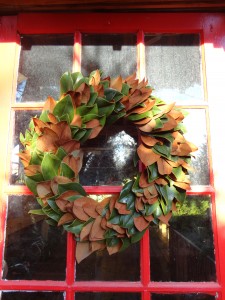
classic magnolia…
Still more come from right here in Alabama – our own homegrown evergreens – chamaecyparis, cedar and magnolia. Truly there is an amazing abundance for your decorating needs!
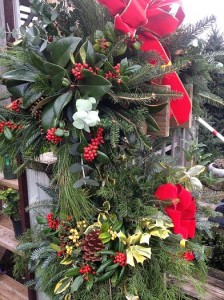
mailbox decorations, displayed at the front of the shop…
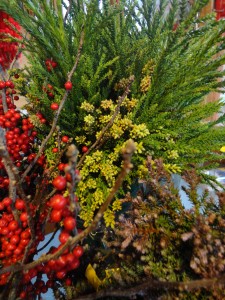
southern greens…
Mailbox decorations are made to order, each one designed with two pieces of caged oasis so the material stays as fresh as possible. Using a base of Fraser fir (It smells so good!), we add as many different greens as are available, inserting berries, pine cones, and a pretty bow to complete the decoration. Pictured here are two of them from last Christmas on display at the front of the shop. Or, if you’d rather make your own, we have the oasis available for you and ribbon galore!
February Construction – Progress!

We’ll be happy to welcome our municipal complex neighbors back this spring!
From what we understand, the fire station directly across from the shop will have big windows where the kids can see the firetrucks when they’re not out. (We’ll just be glad to hear the sound of fire trucks again instead of the beeping of construction crews, and see our friends across the street once more.)
The projected completion date is spring of this year, so we’ll not only be celebrating a new growing season but cheering that we’ll be able to look across the street and see a beautiful, completed city hall, fire and police station too!

